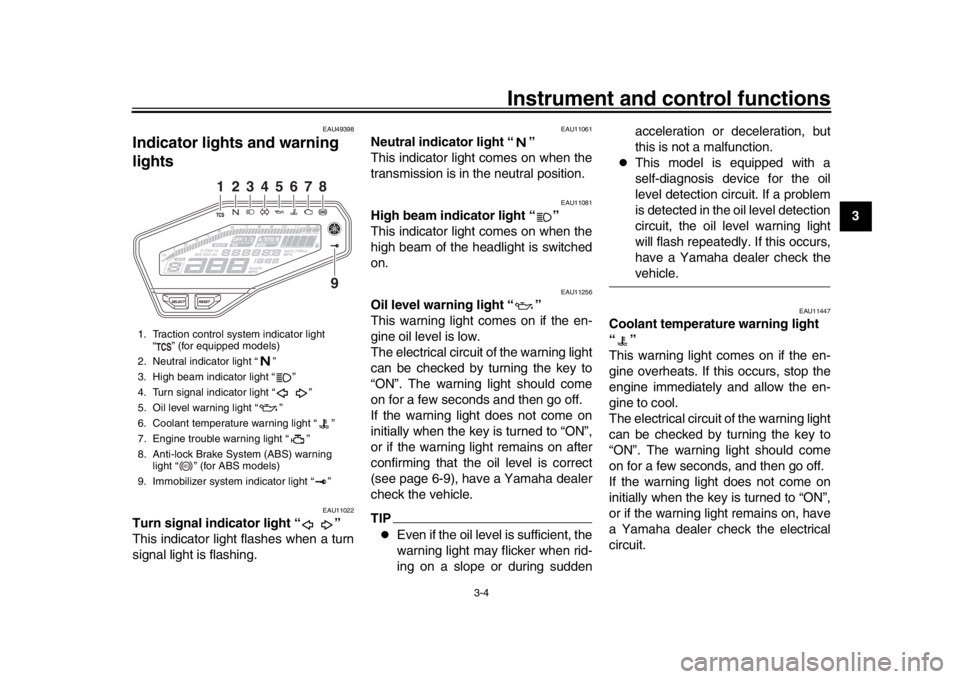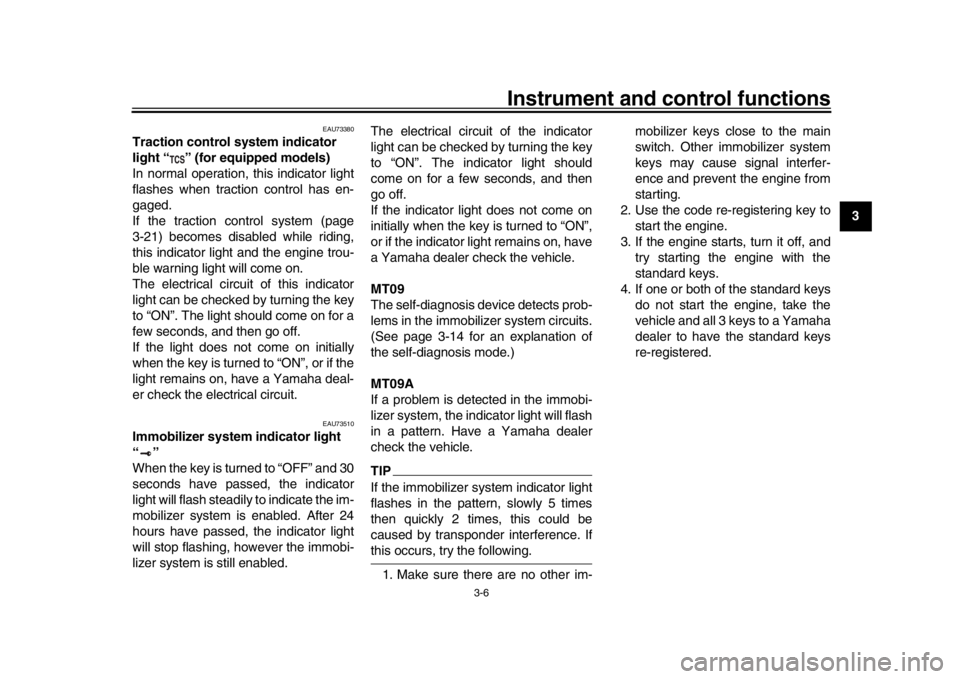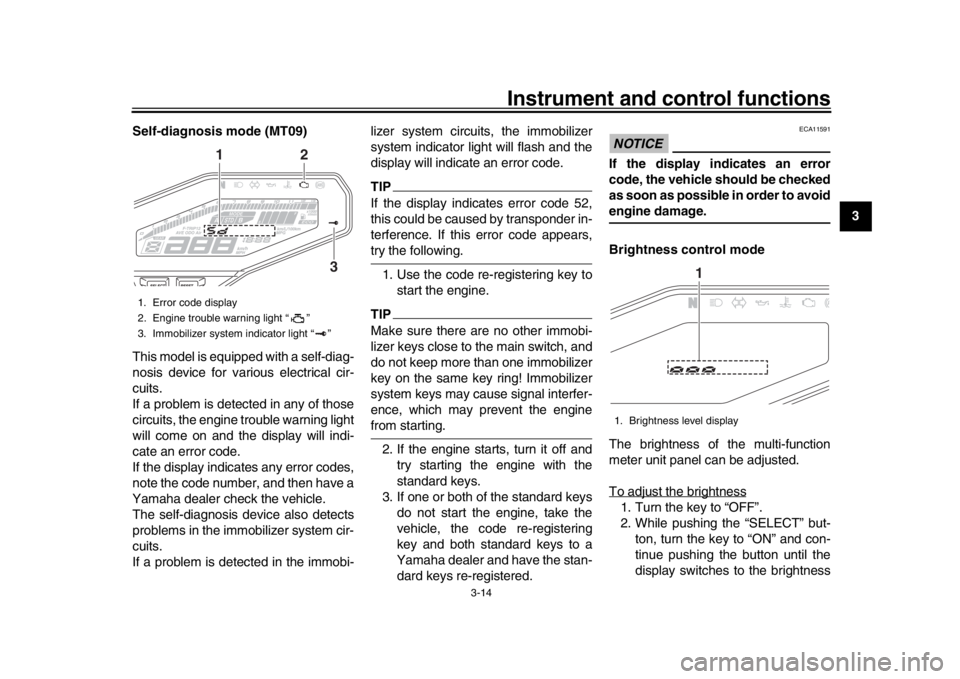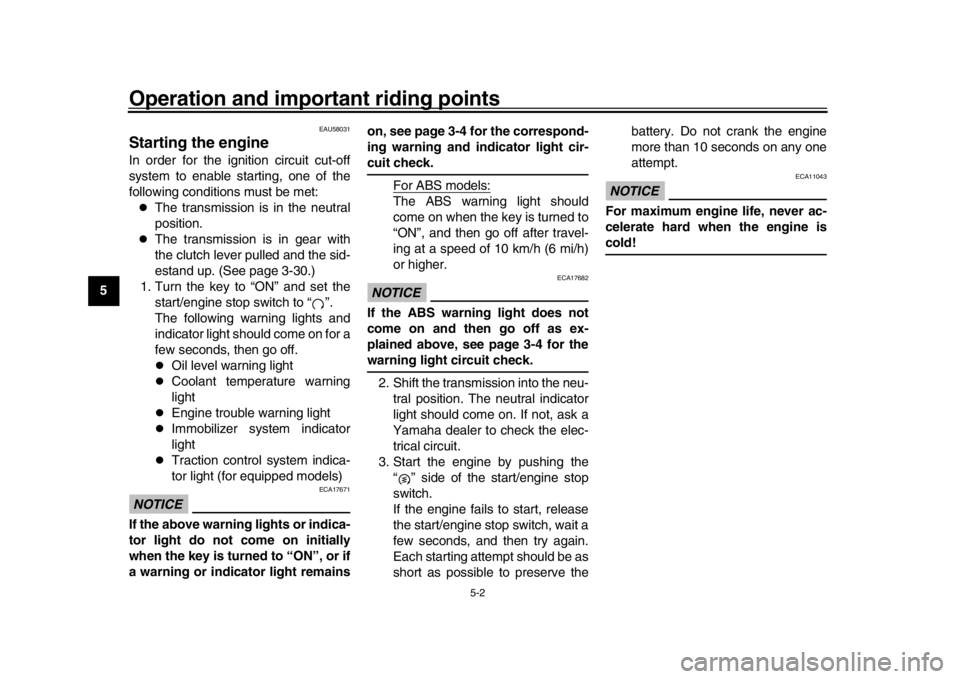check engine light YAMAHA MT-09 2016 Owners Manual
[x] Cancel search | Manufacturer: YAMAHA, Model Year: 2016, Model line: MT-09, Model: YAMAHA MT-09 2016Pages: 114, PDF Size: 4.24 MB
Page 6 of 114

Table of contentsSafety information............................ 1-1
Description ........................................ 2-1
Left view .......................................... 2-1
Right view ........................................ 2-2
Controls and instrument s................. 2-3
Instrument and co ntrol functions.... 3-1
Immobilizer system ....... ................... 3-1
Main switch/steering lock................. 3-2
Indicator lights and warning lights ... 3-4
Multi-function meter unit .................. 3-7
D-mode (drive mode)..................... 3-15
Handlebar switches ....................... 3-16
Clutch lever.................................... 3-18
Shift pedal....... ............................. .. 3-18
Brake lever .................................... 3-19
Brake pedal ................................... 3-19
ABS (for ABS models) .. ................. 3-20
Traction control system
(for equipped models) ................ 3-21
Fuel tank cap ................................. 3-22
Fuel................................................ 3-23
Fuel tank breather hose and overflow hose ............................. 3-24
Catalytic converter ......................... 3-24
Seat ............................................... 3-25
Storage compartment .................... 3-26
Adjusting the front fork................... 3-26
Adjusting the shock absorber assembly .................................... 3-28 Luggage strap holders .
................. 3-29
Sidestand ...................................... 3-30
Ignition circuit cut- off system ......... 3-30
Auxiliary DC connector.................. 3-32
For your safety – pre-operation
checks ............................................... 4-1
Operation and important riding
points ................................................. 5-1
Starting the engine .......................... 5-2
Shifting ............................................ 5-3
Tips for reducing fuel consumption ................................ 5-4
Engine break-in ............................... 5-5
Parking ............................................ 5-5
Periodic maintenance and
adjustment ........................................ 6-1
Owner’s tool kit................................ 6-2
Periodic maintenance chart for the emission control system .............. 6-3
General maintenance and
lubrication chart ........................... 6-4
Checking the spark plugs ................ 6-8
Engine oil and oil filter cartridge ...... 6-9
Coolant .......................................... 6-11
Air filter element ............................ 6-14
Checking the engine idling speed ......................................... 6-15 Checking the throttle grip free
play ............................................. 6-15
Valve clearance ............................. 6-15
Tires ............................................... 6-16
Cast wheels ................................... 6-18
Adjusting the clutch lever free play ............................................. 6-19
Checking the brake lever free
play ............................................. 6-19
Brake light switches ....................... 6-20
Checking the front and rear brake
pads............................................ 6-21
Checking the brake fluid level ........ 6-21
Changing the brake fluid ................ 6-23
Drive chain slack............................ 6-23
Cleaning and lubricating the drive chain ........................................... 6-25
Checking and lubricating the cables ................................... 6-25
Checking and lubricating
the throttle grip and cable ........... 6-26
Checking and lubricating the brake and shift pedals ........ .................. 6-26
Checking and lubricating the brake and clutch levers ........................ 6-27
Checking and lubricating the sidestand .............................. 6-27
Lubricating the swingarm pivots .... 6-28
Checking the front fork................... 6-28
Checking the steering .................... 6-29
Checking the wheel bearings......... 6-29B87-9-E0_1.book 1 ページ 2015年12月16日 水曜日 午前10時21分
Page 14 of 114

Description
2-2
12
3
4
5
6
7
8
9
10
11
12
EAU10421
Right view
2
1
3
4
6
7
8
9
10
5
1. Fuel tank cap (page 3-22)
2. Front fork rebound damping force adjusting screw (page 3-26)
3. Headlight (page 6-34)
4. Fuse box 1 (page 6-31)
5. Coolant reservoir (page 6-11)
6. Engine oil level check window (page 6-9)
7. Engine oil filler cap (page 6-9)
8. Brake pedal (page 3-19) 9. Rear brake light switch (page 6-20)
10.Rear brake fluid reservoir (page 6-21)
B87-9-E0_1.book 2 ページ 2015年12月16日 水曜日 午前10時21分
Page 19 of 114

Instrument and control functions
3-4
1
234
5
6
7
8
9
10
11
12
EAU49398
Indicator lights and warning
lights
EAU11022
Turn signal indicator light “ ”
This indicator light flashes when a turn
signal light is flashing.
EAU11061
Neutral indicator light “ ”
This indicator light comes on when the
transmission is in the neutral position.
EAU11081
High beam indicator light “ ”
This indicator light comes on when the
high beam of the headlight is switched
on.
EAU11256
Oil level warning light “ ”
This warning light comes on if the en-
gine oil level is low.
The electrical circuit of the warning light
can be checked by turning the key to
“ON”. The warning light should come
on for a few seconds and then go off.
If the warning light does not come on
initially when the key is turned to “ON”,
or if the warning light remains on after
confirming that the oil level is correct
(see page 6-9), have a Yamaha dealer
check the vehicle.TIP
Even if the oil level is sufficient, the
warning light may flicker when rid-
ing on a slope or during sudden acceleration or deceleration, but
this is not a malfunction.
This model is equipped with a
self-diagnosis device for the oil
level detection circuit. If a problem
is detected in the oil level detection
circuit, the oil level warning light
will flash repeatedly. If this occurs,
have a Yamaha dealer check thevehicle.
EAU11447
Coolant temperature warning light
“”
This warning light comes on if the en-
gine overheats. If this occurs, stop the
engine immediately and allow the en-
gine to cool.
The electrical circuit of the warning light
can be checked by turning the key to
“ON”. The warning light should come
on for a few seconds, and then go off.
If the warning light does not come on
initially when the key is turned to “ON”,
or if the warning light remains on, have
a Yamaha dealer check the electrical
circuit.
1. Traction control system indicator light
“ ” (for equipped models)
2. Neutral indicator light “ ”
3. High beam indicator light “ ”
4. Turn signal indicator light “ ”
5. Oil level warning light “ ”
6. Coolant temperature warning light “ ”
7. Engine trouble warning light “ ”
8. Anti-lock Brake System (ABS) warning light “ ” (for ABS models)
9. Immobilizer system indicator light “ ”
2
1
3
4
5
6
7
89
ABS
B87-9-E0_1.book 4 ページ 2015年12月16日 水曜日 午前10時21分
Page 20 of 114

Instrument and control functions
3-5
1
23
4
5
6
7
8
9
10
11
12
NOTICE
ECA10022
Do not continue to operate the en-gine if it is overheating.TIP
For radiator-fan-equipped vehi-
cles, the radiator fan(s) automati-
cally switch on or off according to
the coolant temperature in the ra-
diator.
If the engine overheats, see page6-45 for further instructions.
EAU73500
Engine trouble warning light “ ”
MT09
This warning light comes on if a prob-
lem is detected in the electrical circuit
monitoring the engine. If this occurs,
have a Yamaha dealer check the
self-diagnosis system. (See page 3-14
for an explanation of the self-diagnosis
mode.)
The electrical circuit of the warning light
can be checked by turning the key to
“ON”. The warning light should come on for a few seconds, and then go off.
If the warning light does not come on
initially when the key is turned to “ON”,
or if the warning light remains on, have
a Yamaha dealer check the electrical
circuit.
MT09A
This warning light comes on if a prob-
lem is detected in the engine or other
vehicle control system. If this occurs,
have a Yamaha dealer check the
on-board diagnostic system.
The electrical circuit of the warning light
can be checked by turning the key to
“ON”. The warning light should come
on for a few seconds, and then go off.
If the warning light does not come on
initially when the key is turned to “ON”,
or if the warning light remains on, have
a Yamaha dealer check the vehicle.
EAU58530
ABS warning light “ ” (for ABS
models)
In normal operation, the ABS warning
light comes on when the key is turned
to “ON”, and goes off after traveling at a
speed of 10 km/h (6 mi/h) or higher.If the ABS warning light:
does not come on when the key is
turned to “ON”
comes on or flashes while riding
does not go off after traveling at a
speed of 10 km/h (6 mi/h) or higher
The ABS may not work correctly. If any
of the above occurs, have a Yamaha
dealer check the system as soon as
possible. (See page 3-20 for an expla-
nation of the ABS.)WARNING
EWA16041
If the ABS warning light does not go
off after traveling at a speed of 10
km/h (6 mi/h) or higher, or if the
warning light comes on or flashes
while riding, the brake system re-
verts to conventional braking. If ei-
ther of the above occurs, or if the
warning light does not come on at
all, use extra caution to avoid possi-
ble wheel lock during emergency
braking. Have a Yamaha dealer
check the brake system and electri-cal circuits as soon as possible.
ABS
B87-9-E0_1.book 5 ページ 2015年12月16日 水曜日 午前10時21分
Page 21 of 114

Instrument and control functions
3-6
1
234
5
6
7
8
9
10
11
12
EAU73380
Traction control system indicator
light “ ” (for equipped models)
In normal operation, this indicator light
flashes when traction control has en-
gaged.
If the traction control system (page
3-21) becomes disabled while riding,
this indicator light and the engine trou-
ble warning light will come on.
The electrical circuit of this indicator
light can be checked by turning the key
to “ON”. The light should come on for a
few seconds, and then go off.
If the light does not come on initially
when the key is turned to “ON”, or if the
light remains on, have a Yamaha deal-
er check the electrical circuit.
EAU73510
Immobilizer system indicator light
“”
When the key is turned to “OFF” and 30
seconds have passed, the indicator
light will flash steadily to indicate the im-
mobilizer system is enabled. After 24
hours have passed, the indicator light
will stop flashing, however the immobi-
lizer system is still enabled. The electrical circuit of the indicator
light can be checked by turning the key
to “ON”. The indicator light should
come on for a few seconds, and then
go off.
If the indicator light does not come on
initially when the key is turned to “ON”,
or if the indicator light remains on, have
a Yamaha dealer check the vehicle.
MT09
The self-diagnosis device detects prob-
lems in the immobilizer system circuits.
(See page 3-14 for an explanation of
the self-diagnosis mode.)
MT09A
If a problem is detected in the immobi-
lizer system, the indicator light will flash
in a pattern. Have a Yamaha dealer
check the vehicle.
TIPIf the immobilizer system indicator light
flashes in the pattern, slowly 5 times
then quickly 2 time
s, this could be
caused by transponder interference. Ifthis occurs, try the following.
1. Make sure there are no other im- mobilizer keys close to the main
switch. Other immobilizer system
keys may cause signal interfer-
ence and prevent the engine from
starting.
2. Use the code re-registering key to start the engine.
3. If the engine starts, turn it off, and try starting the engine with the
standard keys.
4. If one or both of the standard keys do not start the engine, take the
vehicle and all 3 keys to a Yamaha
dealer to have the standard keys
re-registered.
B87-9-E0_1.book 6 ページ 2015年12月16日 水曜日 午前10時21分
Page 29 of 114

Instrument and control functions
3-14
1
234
5
6
7
8
9
10
11
12
Self-diagnosis mode (MT09)
This model is equipped with a self-diag-
nosis device for vari
ous electrical cir-
cuits.
If a problem is detected in any of those
circuits, the engine trouble warning light
will come on and the display will indi-
cate an error code.
If the display indicates any error codes,
note the code number, and then have a
Yamaha dealer check the vehicle.
The self-diagnosis device also detects
problems in the immobilizer system cir-
cuits.
If a problem is detected in the immobi- lizer system circuits, the immobilizer
system indicator light will flash and the
display will indicate an error code.
TIPIf the display indicates error code 52,
this could be caused by transponder in-
terference. If this error code appears,try the following.
1. Use the code re-registering key to start the engine.TIPMake sure there are no other immobi-
lizer keys close to the main switch, and
do not keep more than one immobilizer
key on the same key ring! Immobilizer
system keys may cause signal interfer-
ence, which may prevent the enginefrom starting.
2. If the engine starts, turn it off and try starting the engine with the
standard keys.
3. If one or both of the standard keys do not start the engine, take the
vehicle, the code re-registering
key and both standard keys to a
Yamaha dealer and have the stan-
dard keys re-registered.
NOTICE
ECA11591
If the display indicates an error
code, the vehicle should be checked
as soon as possible in order to avoidengine damage.
Brightness control mode
The brightness of the multi-function
meter unit panel can be adjusted.
To adjust the brightness1. Turn the key to “OFF”.
2. While pushing the “SELECT” but-ton, turn the key to “ON” and con-
tinue pushing the button until the
display switches to the brightness
1. Error code display
2. Engine trouble warning light “ ”
3. Immobilizer system indicator light “ ”
1
2
3
1. Brightness level display
1
B87-9-E0_1.book 14 ページ 2015年12月16日 水曜日 午前10時21分
Page 52 of 114

Operation and important riding points
5-2
1
2
3
45
6
7
8
9
10
11
12
EAU58031
Starting the engineIn order for the ignition circuit cut-off
system to enable starting, one of the
following conditions must be met:
The transmission is in the neutral
position.
The transmission is in gear with
the clutch lever pulled and the sid-
estand up. (See page 3-30.)
1. Turn the key to “ON” and set the start/engine stop switch to “ ”.
The following warning lights and
indicator light should come on for a
few seconds, then go off.
Oil level warning light
Coolant temperature warning
light
Engine trouble warning light
Immobilizer system indicator
light
Traction control system indica-
tor light (for equipped models)
NOTICE
ECA17671
If the above warning lights or indica-
tor light do not come on initially
when the key is turned to “ON”, or if
a warning or indicator light remains on, see page 3-4 for the correspond-
ing warning and indicator light cir-
cuit check.
For ABS models:
The ABS warning light should
come on when the key is turned to
“ON”, and then go off after travel-
ing at a speed of 10 km/h (6 mi/h)
or higher.
NOTICE
ECA17682
If the ABS warning light does not
come on and then go off as ex-
plained above, see page 3-4 for thewarning light circuit check.2. Shift the transmission into the neu- tral position. The neutral indicator
light should come on. If not, ask a
Yamaha dealer to check the elec-
trical circuit.
3. Start the engine by pushing the “ ” side of the start/engine stop
switch.
If the engine fails to start, release
the start/engine stop switch, wait a
few seconds, and then try again.
Each starting attempt should be as
short as possible to preserve the battery. Do not crank the engine
more than 10 seconds on any one
attempt.
NOTICE
ECA11043
For maximum engine life, never ac-
celerate hard when the engine iscold!
B87-9-E0_1.book 2 ページ 2015年12月16日 水曜日 午前10時21分
Page 61 of 114

Periodic maintenance and adjustment
6-6
1
2
3
4
567
8
9
10
11
12
23 Engine oil Change.
Check oil level and vehicle for oil
leakage.
24 Engine oil filter
cartridge Replace.
25 *Cooling system Check coolant level and vehicle
for coolant leakage.
Change coolant. Every 3 years
26 *Front and rear brake
switches Check operation.
27 Moving parts and
cables Lubricate.
28 *Throttle grip Check operation.
Check throttle grip free play, and
adjust if necessary.
Lubricate cable and grip housing.
29 *Lights, signals and
switches Check operation.
Adjust headlight beam.
NO. ITEM CHECK OR MAINTENANCE JOB
ODOMETER READING
ANNUAL
CHECK
1000 km
(600 mi) 10000 km
(6000 mi) 20000 km
(12000 mi) 30000 km
(18000 mi) 40000 km
(24000 mi)
B87-9-E0_1.book 6 ページ 2015年12月16日 水曜日 午前10時21分
Page 63 of 114

Periodic maintenance and adjustment
6-8
1
2
3
4
567
8
9
10
11
12
EAU19653
Checking the spark plugsThe spark plugs are important engine
components, which should be checked
periodically, preferably by a Yamaha
dealer. Since heat and deposits will
cause any spark plug to slowly erode,
they should be removed and checked
in accordance with the periodic mainte-
nance and lubrication chart. In addition,
the condition of the spark plugs can re-
veal the condition of the engine.
The porcelain insulator around the cen-
ter electrode of each spark plug should
be a medium-to-light tan (the ideal color
when the vehicle is ridden normally),
and all spark plugs installed in the en-
gine should have the same color. If any
spark plug shows a distinctly different
color, the engine could be operating im-
properly. Do not attempt to diagnose
such problems yourself. Instead, have
a Yamaha dealer check the vehicle.
If a spark plug shows signs of electrode
erosion and excessive carbon or other
deposits, it should be replaced. Before installing a spark plug, the spark
plug gap should be measured with a
wire thickness gauge and, if necessary,
adjusted to specification.
Clean the surface of the spark plug
gasket and its mating surface, and then
wipe off any grime from the spark plug
threads.
TIPIf a torque wrench is not available wheninstalling a spark plug, a good estimate
of the correct torque is 1/4–1/2 turn
past finger tight. However, the spark
plug should be tightened to the speci-
fied torque as soon as possible.NOTICE
ECA10841
Do not use any tools to remove or in-
stall the spark plug cap, otherwise
the ignition coil coupler may get
damaged. The spark plug cap may
be difficult to remove because the
rubber seal on the end of the cap fits
tightly. To remove the spark plug
cap, simply twist it back and forth
while pulling it out; to install it, twistit back and forth while pushing it in.
Specified spark plug:
NGK/CPR9EA9
1. Spark plug gapSpark plug gap:0.8–0.9 mm (0.031–0.035 in)
Tightening torque: Spark plug:13 Nm (1.3 m·kgf, 9.4 ft·lbf)
B87-9-E0_1.book 8 ページ 2015年12月16日 水曜日 午前10時21分
Page 64 of 114

Periodic maintenance and adjustment
6-9
1
2
3
4
56
7
8
9
10
11
12
EAU1990A
Engine oil and oil filter
cartridgeThe engine oil level should be checked
before each ride. In addition, the oil
must be changed and the oil filter car-
tridge replaced at the intervals speci-
fied in the periodic maintenance and
lubrication chart.
To check the engine oil level 1. Place the vehicle on a level sur- face and hold it in an upright posi-
tion. A slight tilt to the side can
result in a false reading.
2. Start the engine, warm it up for several minutes, and then turn it
off.
3. Wait a few minutes until the oil set- tles, and then check the oil level
through the check window located
at the bottom-right side of the
crankcase.TIPThe engine oil should be between theminimum and maximum level marks. 4. If the engine oil is below the mini-
mum level mark, add sufficient oil
of the recommended type to raise
it to the correct level.
To change the engine oil (with or
without oil filter cartridge replace-
ment) 1. Place the vehicle on a level sur- face.
2. Start the engine, warm it up for several minutes, and then turn it
off.
3. Place an oil pan under the engine to collect the used oil.
4. Remove the engine oil filler cap, the engine oil drain bolt and its
gasket to drain the oil from the
crankcase.
TIPSkip steps 5–7 if the oil filter cartridge isnot being replaced.
5. Remove the oil filter cartridge with an oil filter wrench.
1. Engine oil filler cap
2. Engine oil level check window
3. Maximum level mark
4. Minimum level mark
1
2
34
1. Engine oil drain bolt
2. Gasket1
2
B87-9-E0_1.book 9 ページ 2015年12月16日 水曜日 午前10時21分